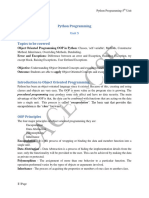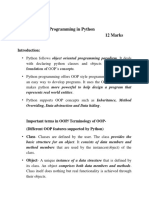Python Programming (Lists, Dictionaries & OOP) : Enterprise Software Engineering
Python Programming (Lists, Dictionaries & OOP) : Enterprise Software Engineering
Uploaded by
abbasi117Copyright:
Available Formats
Python Programming (Lists, Dictionaries & OOP) : Enterprise Software Engineering
Python Programming (Lists, Dictionaries & OOP) : Enterprise Software Engineering
Uploaded by
abbasi117Original Title
Copyright
Available Formats
Share this document
Did you find this document useful?
Is this content inappropriate?
Copyright:
Available Formats
Python Programming (Lists, Dictionaries & OOP) : Enterprise Software Engineering
Python Programming (Lists, Dictionaries & OOP) : Enterprise Software Engineering
Uploaded by
abbasi117Copyright:
Available Formats
Enterprise Software Engineering
LECTURE 3 PYTHON PROGRAMMING (Lists, Dictionaries & OOP)
PG 1
Lists
Lists are similar to arrays in other languages like C/Java etc.
Along-with dictionaries, lists are one of the two most important data structures in python. Many python functions use and return lists.
But these are smart arrays, as these can grow and each element of an array can be of different type including objects and other lists etc.
If you try to access data on a non-existent list index, IndexError is raised.
Example: my_list = [1, 3, 5, 'A', 'B', ['another', 'list'] ]
Elements of a list can be accessed the same way as other languages using square brakets
print(my_list[0])
#prints 1
print(my_list[5][1]) #prints list
PG 2
Lists - Slicing
You can get slices/sub-lists from a list by specifying a range within a list
Examples:
my_list = [1, 3, 5, 'A', 'B', ['another', 'list'] ] new_list = my_list[0:3] #new list is [1,3,5] print(my_list[:5]) print(my_list[3:]) # prints [1, 3, 5, 'A', 'B'] # prints ['A', 'B', ['another', 'list']]
sublist = my_list[-1] # sublist contains ['another', 'list'] To add elements to a list, use the append method Example: my_list.append('another item') Strings also behave like lists so list slicing works with strings too Example: "Hello World"[3:8] #prints 'lo Wo'
PG 3
Lists - Iteration
To iterate all the elements in a list, use the for loop Example: mylist = ['a', 1, 2, 3, 'b'] for item in mylist: print(item)
For iterating thorough nested lists, use nested for loops Example: my_2D_list = [ [ 'Person A', 99, 'Student'], [ 'Person B', 19, 'Professor'], [ 'Person C', 30, 'Lecturer'], [ 'Person D', 50, 'Guard'] ] for row in my_2D_list: for col in row: print col, print
PG 4
Dictionaries Dictionaries are collections of data stored as key-value pairs Data items are accessed or added using their key names given in square brackets If a key does not exist and is accessed KeyError is raised
Use a dictionary object's has_key() method or the in operator to check if a key exists.
Example: my_dict = {'name': 'Anonymous', 'age': 99}
OR my_dict2 = dict(name='anonymous', age=99) print my_dict['name'] print my_dict2['age'] # prints Anonymous # prints 99 #adding another item to the dictionary
my_dict['profession'] = 'Sleeping' my_dict.has_key('name') 'name' in my_dict
# returns True # returns True
PG 5
Lists - Iteration
There are two common methods used to iterate/traverse through all the items in a dictionary.
Example: my_dict = {'name': 'Anonymous', 'age': 99, 'profession': 'student of F09'}
#method 1 for key in my_dict: print key, my_dict[key]
#method 2 for key, val in my_dict.iteritems(): print key, val
PG 6
A More Useful Example
records = [ {'name': 'ABC', 'reg_no': 1000, 'attendance': 20}, {'name': 'XYZ', 'reg_no': 1001, 'attendance': 26}, {'name': 'KDF', 'reg_no': 1002, 'attendance': 30} ]
print("Name\tReg. No\tAttendance") for record in records: print ( "%s\t%i\t%s" % \ (record['name'], record['reg_no'], record['attendance']) )
PG 7
A More Useful Example - Output
Name ABC XYZ KDF
Reg. No Attendance 1000 1001 1002 20 26 30
PG 8
Break
PG 9
Object Oriented Programming - Classes
Python provides excellent OOP facilities to developers. To create a class use the syntax:
class class_name[(parent_class_name)]: #class properties my_prop = value
#constructor def __init__(self): #constructor code
#destructor
def __del__(self): #destructor code
#other class methods etc.
PG 10
Object Oriented Programming Classes Some points
If a class has no parent class it can inherit from the object class
Providing a constructor or a destructor is not required, define these if you need them
A constructor can take arguments
self is a special keyword referring to the current object, all class methods including constructors and destructors should use self as the first argument.
Within the class code refer to all class properties using the self keyword.
Another great thing in python is that objects can have additional methods and properties than just those defined in their class.
Python supports multiple inheritance, that is, a class can have multiple parent classes unlike Java.
PG 11
Object Oriented Programming Classes Example
Please refer to the oop.py file provided with this lecture
Demonstrates the use of classes Demonstrates inheritance and multiple inheritance Demonstrates usage of object attributes by adding an extra property to the bush object
PG 12
Object Oriented Programming Polymorphism
Polymorphism (meaning "having multiple forms") in OOP is referred to the methodology to use the same calling mechanism (for example same function name) and getting different processing based on the data type of parameters passed or the type of object for which the function/method was called.
In python, there is no need to overload functions/methods for working with various data types as python is dynamically typed so no such use of polymorphism is required
Method based polymorphism can be used similar to other languages
Refer to the attached polymorphism.py file to see example of class method polymorphism
PG 13
Q&A
PG 14
You might also like
- Python - OPPSDocument63 pagesPython - OPPSshivakumarhlokeshNo ratings yet
- DS Unit - 1Document23 pagesDS Unit - 1vidhyagNo ratings yet
- OOP Python 1Document127 pagesOOP Python 1dijoveb657No ratings yet
- Oops in PythonDocument11 pagesOops in Pythonaj.suvarnalathaNo ratings yet
- 2 ModulePython OOPs ConceptsDocument29 pages2 ModulePython OOPs Conceptssruthysubash007No ratings yet
- Python Object Oriented Programming OldDocument17 pagesPython Object Oriented Programming OldPriyaGandhiNo ratings yet
- Imp Question - Python Questions by Hari For PlacementDocument12 pagesImp Question - Python Questions by Hari For PlacementPENTAMALLA HARIHARANNo ratings yet
- CP Assignment-5Document31 pagesCP Assignment-5aakash411883No ratings yet
- Chapter 5Document9 pagesChapter 5Sneha NikamNo ratings yet
- Object Oriented Programming OOP in PythonDocument17 pagesObject Oriented Programming OOP in PythonSiyyadri Bhanu Siva Prasad100% (1)
- Ds Unit 1 Data StructuresDocument27 pagesDs Unit 1 Data StructuresTURAGA VIJAYAAKASHNo ratings yet
- Python Projects for Beginners: Part 4. Object-Oriented Programming (OOP). Get an introduction to OOP concepts such as classes, objects, inheritance, and polymorphismFrom EverandPython Projects for Beginners: Part 4. Object-Oriented Programming (OOP). Get an introduction to OOP concepts such as classes, objects, inheritance, and polymorphismNo ratings yet
- 19.python OOPs ConceptsDocument28 pages19.python OOPs Conceptsdasarajubhavani05No ratings yet
- Python Programming: Unit 5Document19 pagesPython Programming: Unit 5Isha TripathiNo ratings yet
- Unit 4 Python LDocument39 pagesUnit 4 Python Lhv6131921No ratings yet
- UNIT-5 EditedDocument22 pagesUNIT-5 Editedaj.suvarnalathaNo ratings yet
- Unit: 4 OOP and File Handling: Prepared By: Ms. Parveen Mor DahiyaDocument48 pagesUnit: 4 OOP and File Handling: Prepared By: Ms. Parveen Mor DahiyaAshim ChaudharyNo ratings yet
- CHAPTER22Document26 pagesCHAPTER22arulmrNo ratings yet
- Python OOPsDocument25 pagesPython OOPsNiranjanNo ratings yet
- Python OOPs Concepts Class and Object and Inhertance AbstractionDocument8 pagesPython OOPs Concepts Class and Object and Inhertance AbstractionSumit TripathiNo ratings yet
- Python Interview QuestionsDocument38 pagesPython Interview QuestionsPavan KumarNo ratings yet
- Class 3 To Class 5 Python OOPs ConceptsDocument33 pagesClass 3 To Class 5 Python OOPs ConceptsRamesh LNo ratings yet
- Unit 07 OOPs in Python 1Document27 pagesUnit 07 OOPs in Python 1Altaf MukadamNo ratings yet
- Chapter SixDocument26 pagesChapter SixlakbrmulatuNo ratings yet
- UNIT V - PythonDocument10 pagesUNIT V - PythonPrakash MNo ratings yet
- Python Preguntas EntrevistaDocument26 pagesPython Preguntas EntrevistajesusrblNo ratings yet
- 5-Dictionariess and InheritanceDocument14 pages5-Dictionariess and InheritanceB happyNo ratings yet
- Python Assignment Using TkinterDocument16 pagesPython Assignment Using TkinterSahil ChauahanNo ratings yet
- Introduction To PYTHONDocument98 pagesIntroduction To PYTHONVishal AnandNo ratings yet
- Python Interview Q A 1709697988Document26 pagesPython Interview Q A 1709697988Suman SaurabhNo ratings yet
- PythonDocument6 pagesPythonSonali MethaniyaNo ratings yet
- 3rd Sem Python 2023 MQ Paper With SolutionDocument27 pages3rd Sem Python 2023 MQ Paper With SolutionBrijesh C.GNo ratings yet
- Unit 5Document25 pagesUnit 5goneakshataNo ratings yet
- Module 4Document67 pagesModule 4AlthafNo ratings yet
- Dsup 2Document19 pagesDsup 2Nikhil YadavNo ratings yet
- Introduction To OOPs in Python2Document7 pagesIntroduction To OOPs in Python2SANJAYNo ratings yet
- Apj Abdul Kalam Technological Uni Versi Ty: Syllabus - Study Materials - Textbook PDF - Solved Question PapersDocument29 pagesApj Abdul Kalam Technological Uni Versi Ty: Syllabus - Study Materials - Textbook PDF - Solved Question PapersShibilas K pNo ratings yet
- Python Interview Questions 1714477282Document26 pagesPython Interview Questions 1714477282mahesh bochareNo ratings yet
- Python Notes Module5Document34 pagesPython Notes Module5Dr. Rama Satish K VNo ratings yet
- Sets and DictionariesDocument19 pagesSets and DictionariesSAI PRAMOD RAVADANo ratings yet
- Object-Oriented Programming: FeaturesDocument10 pagesObject-Oriented Programming: FeaturesAnonymous utfuIcnNo ratings yet
- Python Unit - 4Document12 pagesPython Unit - 4Tasneem khanNo ratings yet
- Unit-3 OOPSDocument5 pagesUnit-3 OOPSA2 MotivationNo ratings yet
- Unit3py 240928091622 0ea1eac8Document82 pagesUnit3py 240928091622 0ea1eac8Raza AhmadNo ratings yet
- Python Interview Questions With AnswersDocument32 pagesPython Interview Questions With AnswersKrishnqNo ratings yet
- Unit 3 Web ComputingDocument9 pagesUnit 3 Web ComputingTejaswini PawarNo ratings yet
- Object and ClassDocument30 pagesObject and ClassAshutosh TrivediNo ratings yet
- Python UNIT 5Document6 pagesPython UNIT 5rajanikanthNo ratings yet
- Mech PythonDocument30 pagesMech PythonMrunali KudtarkarNo ratings yet
- Oop Mid Term Lab AssignmeentDocument6 pagesOop Mid Term Lab AssignmeentM Asif khanNo ratings yet
- Unit 5 PWP PSGDocument34 pagesUnit 5 PWP PSGTAIBA SHAIKHNo ratings yet
- Java Unit 3Document4 pagesJava Unit 3anonymousNo ratings yet
- PWP - Chapter 5Document41 pagesPWP - Chapter 5Mayur Narsale100% (1)
- Unit-I OOPDocument148 pagesUnit-I OOPDhruti PatelNo ratings yet
- Python Shorts NotesDocument34 pagesPython Shorts Notesenet5566No ratings yet
- New Section 1 Print PythonDocument1 pageNew Section 1 Print Pythondurgeshpujari9No ratings yet
- C++ (C With Classes) : Object Oriented Programming (OOP)Document77 pagesC++ (C With Classes) : Object Oriented Programming (OOP)snathick100% (1)
- Python Objects and ClassesDocument2 pagesPython Objects and ClassesInderpal SinghNo ratings yet
- 5 Object Oriented Programming in PythonDocument22 pages5 Object Oriented Programming in PythonSpNo ratings yet
- Python Most Asked Interview Questions?Document24 pagesPython Most Asked Interview Questions?Sumit SutarNo ratings yet
- Postcolonialism Suffering and AffectiveDocument14 pagesPostcolonialism Suffering and Affectiveabbasi117No ratings yet
- Background Document To Symposium ITEL-FINALDocument7 pagesBackground Document To Symposium ITEL-FINALabbasi117No ratings yet
- First Issue: A War in The Sand' byDocument29 pagesFirst Issue: A War in The Sand' byabbasi117No ratings yet
- Analyzing The ProblemDocument19 pagesAnalyzing The Problemabbasi117No ratings yet
- Software Requirement Engineering: INSTRUCTOR: Talat Ambreen 6 Team SkillsDocument13 pagesSoftware Requirement Engineering: INSTRUCTOR: Talat Ambreen 6 Team Skillsabbasi117No ratings yet
- Things Fall ApartDocument13 pagesThings Fall Apartabbasi117No ratings yet
- PsychologyDocument524 pagesPsychologyabbasi117No ratings yet
- 6063dwv10pfi1 - Asga 8' FHS 409911 Ad4 4Z2TP - 03 - 003 - A3Document1 page6063dwv10pfi1 - Asga 8' FHS 409911 Ad4 4Z2TP - 03 - 003 - A3Dang SonNo ratings yet
- Epcon C8: Steel Reinforcement Fixings For Reinforced ConcreteDocument3 pagesEpcon C8: Steel Reinforcement Fixings For Reinforced ConcreteAhmed Samir SalimNo ratings yet
- Microcontrollers Chapter 1 SlidesDocument11 pagesMicrocontrollers Chapter 1 SlidesDawod SalmanNo ratings yet
- LV InsulatorDocument4 pagesLV InsulatorpraveenniteenNo ratings yet
- Magnetic Flow E&HDocument20 pagesMagnetic Flow E&HThanachai TengjirathanapaNo ratings yet
- 4 Kaltwasser N UWD SB 13 WELLHEAD SYSTEM DEA Presentation PDFDocument23 pages4 Kaltwasser N UWD SB 13 WELLHEAD SYSTEM DEA Presentation PDFsabilco13No ratings yet
- Babbitt MetalDocument23 pagesBabbitt MetalAshish Rawat100% (1)
- Question PaperDocument8 pagesQuestion PaperNAND KISHOR GUPTANo ratings yet
- Second Moment AreaDocument17 pagesSecond Moment AreaAsyraaf YapNo ratings yet
- Parts List: MODEL: MEB-3810 List No: 1593-05Document96 pagesParts List: MODEL: MEB-3810 List No: 1593-05Fausto DeseoNo ratings yet
- Introduction To Cutting Tool DesignDocument15 pagesIntroduction To Cutting Tool DesignChrystelle DayneNo ratings yet
- 21BCA1946 Worksheet1.6Document5 pages21BCA1946 Worksheet1.6Divya Prakash SinghNo ratings yet
- Experiment No 7 EACM LAB II - 241007 - 184729Document4 pagesExperiment No 7 EACM LAB II - 241007 - 184729yashmahajan1205No ratings yet
- Javacore 20130612 202204 1112 0002Document210 pagesJavacore 20130612 202204 1112 0002uavitalaNo ratings yet
- Automatic Engine Control Unit Operators Manual: Kutai Electronics Industry Co., LTDDocument11 pagesAutomatic Engine Control Unit Operators Manual: Kutai Electronics Industry Co., LTDalexanderNo ratings yet
- Part 8 - Auxiliary Equipment PDFDocument80 pagesPart 8 - Auxiliary Equipment PDFDota Ng75% (4)
- TP-SA-016 Brookfield Viscosity Carbopol After Salt AdditionDocument5 pagesTP-SA-016 Brookfield Viscosity Carbopol After Salt AdditionCatarinaNo ratings yet
- Three Star Auto Spare Parts Trdg. - THB: 04-10-0011 26/08/2021 Top Concrete PO - BOX: 12515 050305999 06 8823055Document1 pageThree Star Auto Spare Parts Trdg. - THB: 04-10-0011 26/08/2021 Top Concrete PO - BOX: 12515 050305999 06 8823055syed ahmedNo ratings yet
- Department of Technical Education Andhra PradeshDocument32 pagesDepartment of Technical Education Andhra PradeshSHEKHARNo ratings yet
- Triton Atm Error CodesDocument37 pagesTriton Atm Error CodesosirazNo ratings yet
- Structural Joint FailuresDocument4 pagesStructural Joint FailuresManoj ManoharanNo ratings yet
- Sto GSTDocument7 pagesSto GSTPankaj Sinha100% (2)
- Lenovo S200z AIO Service Parts Listing: Machine Type: 10HA, 10K1, 10K4, 10K5Document11 pagesLenovo S200z AIO Service Parts Listing: Machine Type: 10HA, 10K1, 10K4, 10K5hernan sotoNo ratings yet
- Lectures Section 3 ModifiedDocument73 pagesLectures Section 3 ModifiedcoventryUkNo ratings yet
- The Ongoing Revolution in Software Testing GG GDocument56 pagesThe Ongoing Revolution in Software Testing GG Gapi-27294532No ratings yet
- Sizing Medical Gas PipingDocument6 pagesSizing Medical Gas PipingYoke Shu100% (1)
- Spin Casting RunnerDocument7 pagesSpin Casting RunnerTri WidayatnoNo ratings yet
- Design and Fabrication of Crude Distillation Unit Components For A Mini Petroleum RefineryDocument269 pagesDesign and Fabrication of Crude Distillation Unit Components For A Mini Petroleum RefineryDia Fatima MaguikayNo ratings yet
- C GVSP 04Document2 pagesC GVSP 04rab_forceNo ratings yet
- Samsung HT-D5210C Home Theater ManualDocument85 pagesSamsung HT-D5210C Home Theater ManualomraamNo ratings yet
































































































